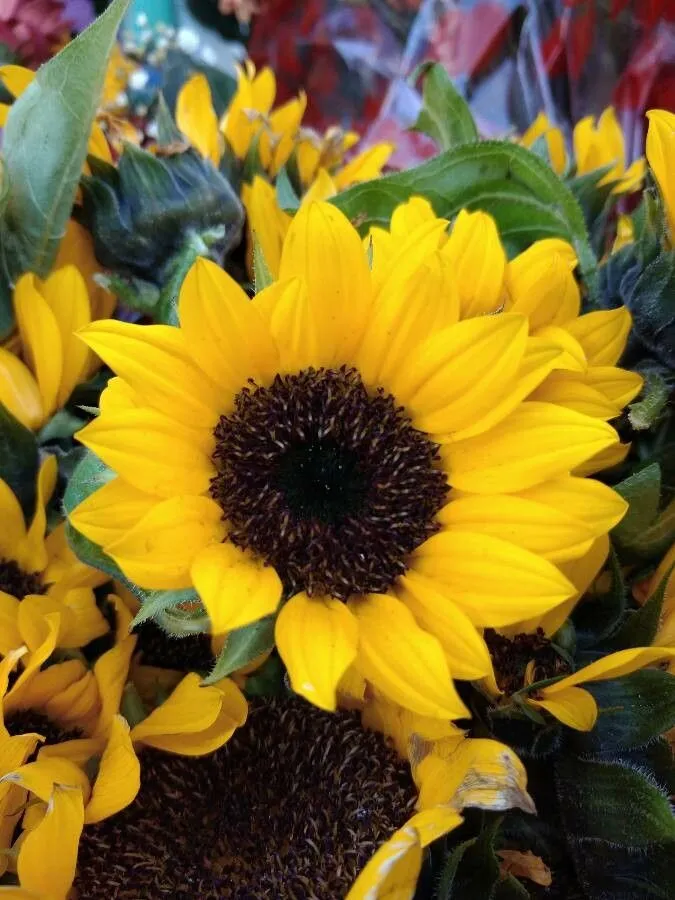
Author: Nutt.
Bibliography: J. Acad. Nat. Sci. Philadelphia 2: 115 (1821)
Year: 1821
Status: accepted
Rank: species
Genus: Helianthus
Vegetable: Unknown
Observations: Canada to N. Mexico
The Plains sunflower, scientifically known as Helianthus petiolaris, is a remarkable plant native to North America. This species was first described in 1821 by the eminent botanist Thomas Nuttall in the Journal of the Academy of Natural Sciences of Philadelphia. The vibrant and resilient Plains sunflower belongs to the Asteraceae family, a large and diverse family commonly referred to as the aster, daisy, or sunflower family.
Plains sunflowers can be found thriving across a wide range of territories, extending from Canada in the north to northern Mexico. This distribution underscores their adaptability to various climatic and soil conditions across North America. The plant is particularly notable for its preference for open, sunny locations, often favoring prairies, meadows, and roadsides where it can bask in plenty of sunlight.
Characterized by its bright yellow petals and dark, seed-rich centers, the Plains sunflower blooms prolifically during the summer months, often creating stunning displays of golden fields. The flowers generally grow on tall, slender stems that can reach impressive heights, contributing to their prominence in the landscape.
The Helianthus petiolaris plays a crucial ecological role. Its flowers attract a wide range of pollinators, including bees, butterflies, and other insects, which are essential for the fertilization process. Additionally, the seeds of the Plains sunflower provide a valuable food source for various bird species, further embedding the plant within the food chain of its native habitats.
This sunflower’s hardiness and beauty make it a popular choice for wildflower gardens and as a decorative species in landscaping. Its ability to thrive in less-than-ideal soil conditions makes it a low-maintenance option for gardeners seeking to enhance biodiversity.
In summary, the Plains sunflower, with its striking appearance and ecological significance, is a plant that bridges the delicate balance between ornamental beauty and environmental utility. Its widespread presence from Canada to northern Mexico serves as a testament to its versatility and enduring appeal.
Deu: blattstiel-sonnenblume, gestielte sonnenblume
Lit: ilgakotė saulėgrąža
Eng: lesser sunflower, petioled sunflower, plains sunflower, prairie sunflower, showy sunflower, deceptive sunflower, kansas sunflower, prarie sunflower
Dan: purpur-solsikke
Ces: slune
Swe: hamnsolros
Fra: hélianthe des prairies, hélianthe de la prairie
Cym: blodyn-yr-haul bach
En: Plains sunflower, Prairie sunflower, Petioled sunflower, Lesser sunflower, Annual sunflower, Showy sunflower, Deceptive Sunflower, Kansas sunflower, Prarie Sunflower
Cs: Slune
Da: Purpur-solsikke
Fi: Pikkuauringonkukka
Fr: Hélianthe des prairies, Hélianthe de la Prairie
De: Blattstiel-Sonnenblume, Gestielte Sonnenblume
Lt: Ilgakotė saulėgrąža
Sv: Hamnsolros
Cy: Blodyn-yr-haul bach
Taken Jul 21, 2021 by Charlotte Weddington (cc-by-sa)
Taken Mar 5, 2022 by Rourke Karen (cc-by-sa)
Taken Aug 10, 2021 by William Coville (cc-by-sa)
Taken Aug 1, 2022 by Rvt 063 (cc-by-sa)
Taken Jan 3, 2022 by Alp Aslan (cc-by-sa)
Taken Aug 27, 2022 by Chris L (cc-by-sa)
Taken Oct 5, 2022 by Jean-François Latour (cc-by-sa)
Taken Jul 26, 2021 by Cathy Maguire (cc-by-sa)
Taken Aug 27, 2022 by Barb T (cc-by-sa)
Taken Aug 10, 2021 by William Coville (cc-by-sa)
Taken Jul 16, 2015 by EOL − acreman (cc-by-nc)
Taken Aug 15, 2013 by EOL − Simon Kingston (cc-by-nc)
Taken Sep 8, 2021 by Emile Van Dingenen (cc-by-sa)
Taken Dec 12, 2014 by EOL − Keir Morse (cc-by-nc-sa)
Taken Jul 12, 2021 by Jeff Potts (cc-by-sa)
Taken Sep 12, 2022 by Cameron Waibel (cc-by-sa)
Taken Dec 12, 2014 by EOL − Keir Morse (cc-by-nc-sa)
Taken Dec 12, 2014 by EOL − Keir Morse (cc-by-nc-sa)
Taken Jan 1, 1900 by EOL − Gerrit Davidse (cc-by-nc-sa)
Taken Nov 26, 2021 by gideon van melle (cc-by-sa)
Taken Jan 1, 1900 by EOL − Gerrit Davidse (cc-by-nc-sa)
Taken Dec 12, 2014 by EOL − Keir Morse (cc-by-nc-sa)
Taken Jan 1, 1900 by EOL − Gerrit Davidse (cc-by-nc-sa)
Taken Jul 26, 2021 by Cathy Maguire (cc-by-sa)
© copyright of the Board of Trustees of the Royal Botanic Gardens, Kew.
© copyright of the Board of Trustees of the Royal Botanic Gardens, Kew.
Family: Myrtaceae Author: (F.Muell.) K.D.Hill & L.A.S.Johnson Bibliography: Telopea 6: 402 (1995) Year: 1995 Status:…
Family: Rubiaceae Author: Pierre ex A.Froehner Bibliography: Notizbl. Bot. Gart. Berlin-Dahlem 1: 237 (1897) Year:…
Family: Sapindaceae Author: Koidz. Bibliography: J. Coll. Sci. Imp. Univ. Tokyo 32(1): 38 (1911) Year:…
Family: Asteraceae Author: A.Gray Bibliography: Pacif. Railr. Rep.: 107 (1857) Year: 1857 Status: accepted Rank:…
Family: Fabaceae Author: Medik. Bibliography: Vorles. Churpfälz. Phys.-Ökon. Ges. 2: 398 (1787) Year: 1787 Status:…
Family: Aspleniaceae Author: (Cav.) Alston Bibliography: Bull. Misc. Inform. Kew 1932: 309 (1932) Year: 1932…